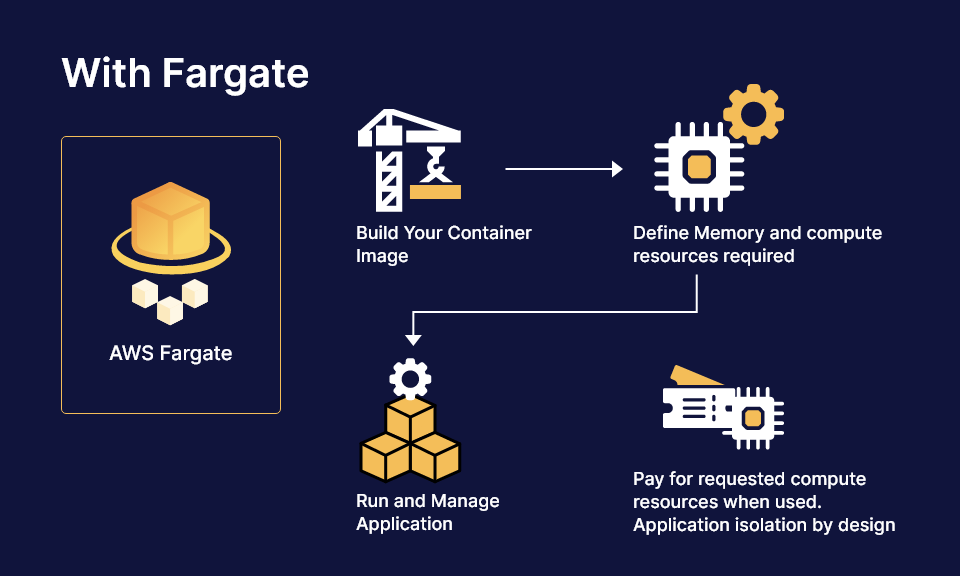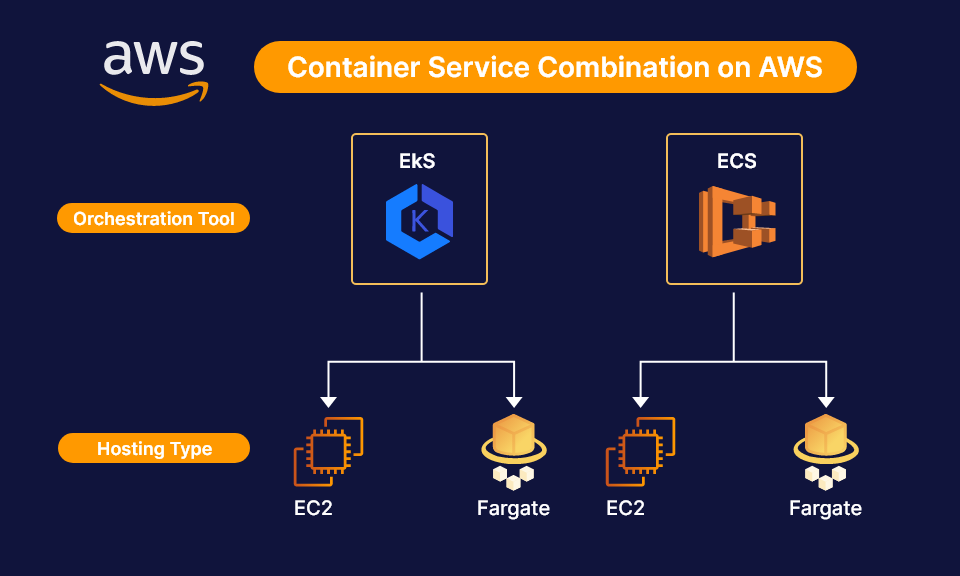Kubernetes and AWS Fargate both aim towards easing off the container orchestration process. The core feature of both is to deploy and manage containerized applications. In a way, Fargate seems to be an extension of upstream Kubernetes. Yet there exists some distinct differences which become the deciding factor when choosing one above the other.
What Is AWS Fargate?
AWS Fargate is a container orchestration engine introduced by AWS in 2017. It follows a serverless approach to setting up and managing the infrastructure required to deploy and host containers (containerized applications). Fargate automatically provisions the infrastructure for your containers on a per-request basis, without the need for developers to build the infrastructure or provision their own clusters.
With AWS Fargate, developers can focus on building their applications, as the platform handles the underlying infrastructure. Each node in the infrastructure runs in an isolated kernel, ensuring secure isolation. This means developers can concentrate on building and scaling their applications without worrying about the complexities of managing the infrastructure.

What Is Kubernetes?
Kubernetes is an open-source container orchestration engine originally developed by Google. It helps in organizing applications into groups of containers, which are run using the Docker engine. Kubernetes ensures that the containers within an application are deployed, monitored, and kept running according to user specifications. Kubernetes is cloud-agnostic and can be installed in both public and on-premise cloud environments.
Kubernetes offers a variety of automation and abstraction features like automated container deployment, horizontal and vertical scaling, load balancing, rollbacks, and the ability to restart failed containers. Amazon provides a managed Kubernetes service called Amazon EKS (Elastic Kubernetes Service) to simplify the deployment, management, and scaling of Kubernetes clusters in AWS environments.
Relation Between AWS Fargate and Kubernetes
While both AWS Fargate and Kubernetes share the same goal of simplifying container orchestration, they are distinct in terms of functionality and scope. Fargate operates as a container management platform, providing broader capabilities, while Kubernetes focuses primarily on container orchestration.
Fargate manages infrastructure within EKS (an Amazon Kubernetes service platform). However, it is not limited to Kubernetes and can also deploy and manage containers through ECS (Elastic Container Service), which is another AWS container orchestration tool. This means that Fargate can be used to manage clusters outside of Kubernetes as well.

ECS on Fargate Vs. EKS on Fargate
- ECS (Elastic Container Service) is AWS’s own container service and integrates well with the AWS ecosystem, including services like CloudTrail, CloudWatch, and Amazon ECR (Elastic Container Registry). The ECS control panel is free, making it a cost-effective solution for developers.
- EKS (Elastic Kubernetes Service), on the other hand, uses Kubernetes for container orchestration and supports Kubernetes-native features like Horizontal Pod Autoscaler (HPA) and Cluster Autoscaler (CA). These features make EKS suitable for Kubernetes environments that require fine-grained control over workloads. Additionally, EKS supports EC2 spot instances, which offer significant cost savings.
Both services allow you to deploy and manage containerized applications, but ECS offers a simpler, AWS-native experience, while EKS provides the flexibility of Kubernetes’ ecosystem and tools.
AWS Fargate Vs. Kubernetes: Differences
-
Infrastructure Provisioning: Fargate automatically provisions infrastructure for containers, while Kubernetes requires administrators to manually provision nodes, unless the distribution supports node autoscaling. Fargate handles this process autonomously, removing the complexity for developers.
-
Serverless Architecture: Fargate operates in a serverless architecture, meaning there’s no need to manage servers. Kubernetes, however, uses a distributed server-based model, which requires more infrastructure management.
-
Plugins: Kubernetes has a large ecosystem of plugins, enabling significant customizability for developers. In contrast, Fargate offers fewer customization options, which might limit flexibility in some scenarios.
-
Platform Dependencies: Fargate is tightly integrated with AWS services, whereas Kubernetes is a cross-platform orchestration tool, which can run on various cloud environments or on-premises. This makes Kubernetes a better option for businesses aiming for platform independence.
-
Monitoring: Fargate integrates well with AWS’s monitoring tools, such as CloudWatch and CloudTrail. Kubernetes does not come with default monitoring tools, but it can be supplemented with third-party tools for monitoring containerized environments.
AWS Fargate Vs. Kubernetes: How to choose?
Choosing between AWS Fargate and Kubernetes largely depends on the specific needs of your application and development process:
Kubernetes is better suited when:
- You need extensive control over workload configuration.
- OS-level access to infrastructure is required.
- You are using third-party tools that are not supported by Fargate.
- You need to manage workloads within virtual machines (VMs).
AWS Fargate is ideal when:
- You want to avoid writing complex configurations for networking, storage plugins, RBAC, etc.
- You need a high scalability solution that can scale quickly and efficiently.
- Your workloads don’t require strict isolation compliance.
- Your containerized workloads are relatively simple and straightforward, making Fargate a more streamlined choice.
In conclusion, the decision between Fargate and Kubernetes should be based on your project’s complexity, scalability needs, and whether the flexibility of Kubernetes or the simplicity of Fargate is more appropriate for your use case. Both services provide powerful container orchestration solutions, but their key differences make them suitable for different types of containerized applications.
